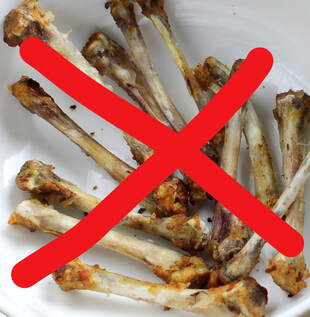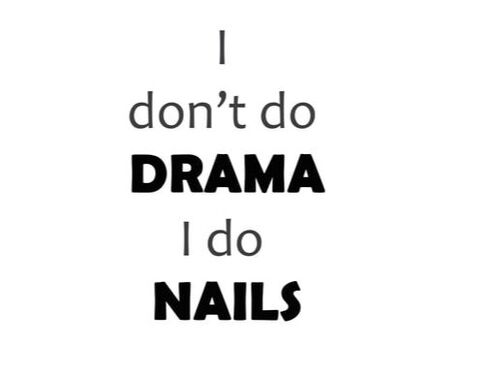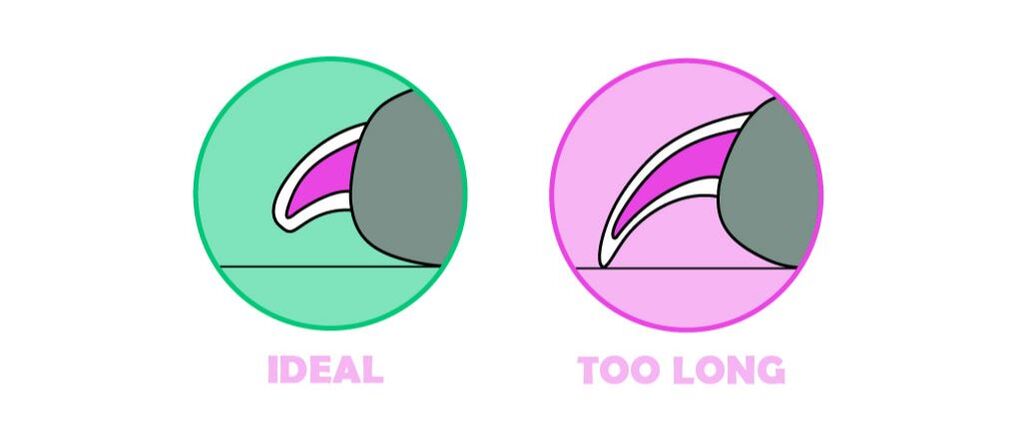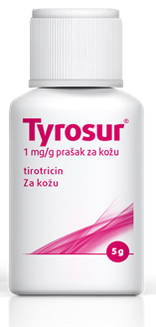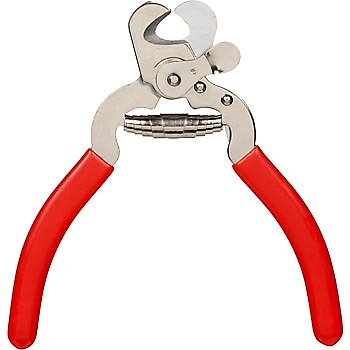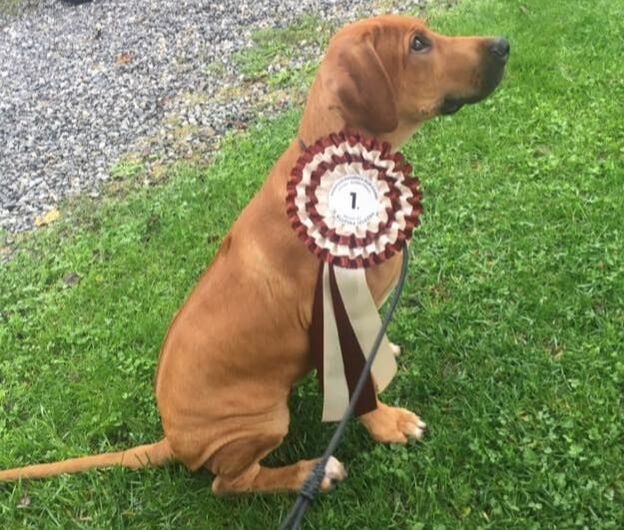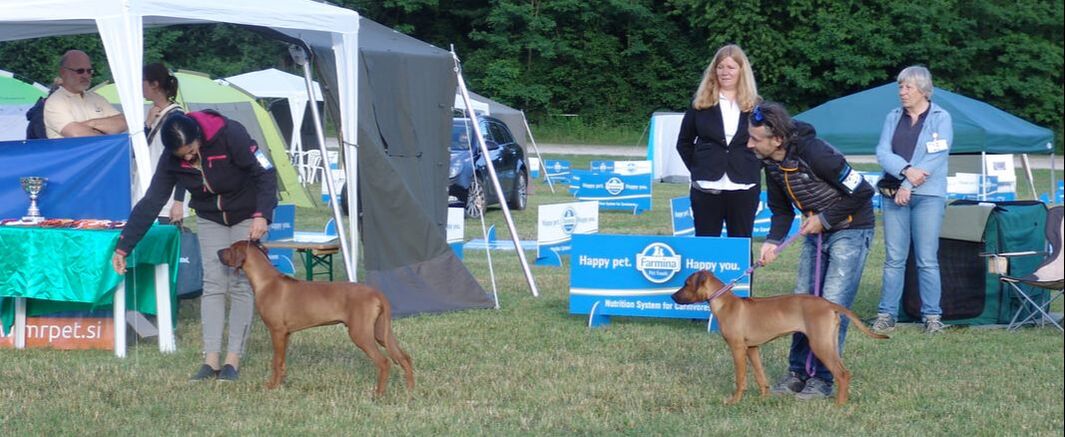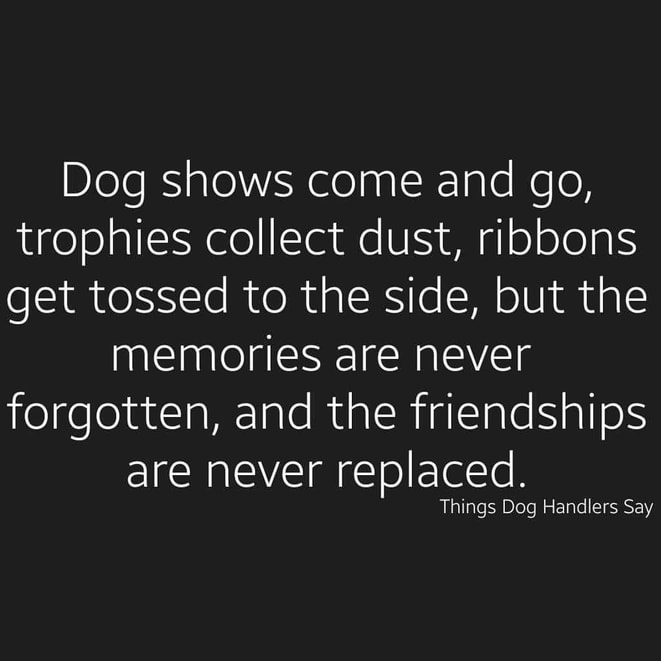|
What dog doesn't love a good bone? Just make sure you are buying a good one! From time to time it is ok to give your dog to chew a bone. The teeth plaque will be cleaned, your dog will have fun and will be mentally stimulated but there is a danger in those tasty bones! Chewing is a natural instinct for dogs. Bones are a great way to keep happy a dog who is bored! Like beef femurs or marrow bones, "Recreation bones" are great for letting your dog activate their jaw but aren’t to be consumed. Chewing is a favourite pastime for most dogs and giving them a bone will help to keep them both physically and mentally occupied. Usually, chewing bones keeps your pup out of trouble and ensures that they are chewing on something healthy instead of your shoes. Bones are a good source of minerals and other nutrients and help satisfy your dog. Chewing stimulates saliva enzymes and helps prevent plaque buildup on teeth and possible gum disease. Be sure to choose bones that contain marrow and connective tissues, as this will provide the most nutrition. Bones contain a variety of minerals that can aid in skin and coat health, and the marrow and cartilage are good sources of collagen. Bones with connective tissues attached are especially beneficial for skin and coat health. However, many veterinarians believe it just isn’t worth the risk of serious injuries to give your dog a bone. If you are considering giving him a bone, here are some rules to follow for his safety. Bones should only be given to dogs under supervision, and they should never be left alone with them! Don’t give your dog the wrong kind of bone. Ideal bones for dogs are round bones with bulges or lumps at either end, like leg bones. Many other types of bones are easier for dogs to break with their bite, and are more likely to cause problems.. No chicken drumsticks to dogs, nor wishbones. Don't feed your dog with pork bones or rib bones. They're more likely to splinter than other types of bones. Don't give your dog fish bones! Look for beef, elk, moose, or deer antlers and bones. Knuckles Hock bones Kneecaps Necks Don’t give you dog cooked bones of any kind.
Cooked bones, including those that come from table scraps, are not safe for dogs to eat. They can easily break and splinter. Cooked bones are not recommended under any circumstance. Don’t let your dog chew any kind of bone into small pieces. Don’t give your dog chunks of bone that can cause blockages. Don’t give your dog a bone if he has stomach problems. Don’t give your dog a bone to chew on if there’s another dog around. Never let a dog bury a bone, nor dig them up later on to eat! Old or buried bones grow bacteria on them that can cause infection. Offer raw meat bones. One disadvantage about raw bones is that they can carry bacteria like salmonella or e-coli and can spoil in a few days if not eaten. Dogs' strong stomach acid helps break bones down, and kills potential bacteria but it is the best that you always freeze the bone, and then defreeze it to the room temperature before you give it to your dog! Take the bone away from your dog after 10-to-15 minutes, and put it in the refrigerator. Dispose of a bone after few days. Never let your dog to eat the bone to its end because there is a danger that the dog will swallow when it becomes small. Once the bone has been picked clean of all bits and yummy flavouring, then take the bone away and discard it. Give your Ridgie a large bone!
0 Comments
Rhodesians have fast growing nails and this is something you should always take care about! Your puppy has been taught to cut nails regularly in the kennel. (every 7 -10 days). You need to work on ensuring that your dog feels comfortable with this task. Go on your puppy paws as much as you can! Hold it, press it, play with fingers and nails and do this on a daily basis. Reward your dog with treat after every nail you cut! You want them to associate nail trimming with something positive! Form positive associations with this by rewarding your dog with treats and praise until allows you to clip her nails without getting nervous. You can do this by gradually introducing your dog to the clippers or the grinder&trimmer and getting used to having her paws handled. Our secret is also that it is good to cut nails while they are sleepy. You must continue with by regular cutting to keep him and the reasons are the following: Puppy will be accustomed! Your dog will be accustomed and you will always be able to cut the nails without the stress and your dog running out of the room, panting in drama. It will be so much easier to both of you :) It is definitely better to cut your dog's nails in sofa than to go to the Vet and to have a drama of life.... Please take this seriously! The "quick" in the nails will not be extended Too long nails are not good! When dog nails get too long, it can lead to pain and other serious issues. Over time, your dog might develop spine and posture problems (like sitting or standing oddly) due to frequently shifting weight because of overgrown nails. Too-long nails can even lead to difficulty walking, lameness or serious injury; especially if they’re so long that they touch the ground. In general, nails that are too long can limit your dog’s movements. The pasterns that begin to bend if they are too long, and thus the statics of the whole body are disturbed, also too long nails for a long time may cause paw deformation. Nails that are too long are at risk of being torn off, such as if your dog’s nail gets caught on a piece of carpeting or furniture. This can result in an injury that might require veterinary care if it’s serious enough. When your dog’s nails hit the floor constantly as dog walks, this can put more pressure on the nail bed. This pressure can cause discomfort that forces your dog to distribute her weight differently while she walks, which can affect the way her toe and paw joints are aligned. BE COOL AND CONFIDENT IN PROCEDURE! Ridgebacks are experts in reading our body language and energy. If your dog reads your inner panic or stress, be sure that the dog be also bee stressed! When you trim your dog’s nails, hold the clippers at a 45-degree angle. Clip each nail carefully so that you don’t accidentally cut into the quick, which is the live part of the nail. NEVER PUT THE WHOLE NAIL INTO CLIPPER! CUT IT PIECE BY PIECE TILL YOU DO NOT GET CLOSE TO THE LIVE PART OF THE NAIL! Otherwise your dog will fell the pain and then it is probably The END... Finito! Good bye..... Drama is ON forever probably if the dog starts to connect the pain with clippers! This means stopping before you reach the pink part if your dog has white nails. For black nails, stop clipping when you no longer see a whitish interior. What if you cut too much and the nail starts to bleeding? Your dog moved at the last second, you couldn't see what you were doing, you sneezed at the wrong time—whatever the reason, there's no need to panic if you cut the nail too short. Simply press a pinch of styptic powder, corn starch or flour to the nail and apply pressure until it stops bleeding, and let the God help you that your dog does not get in drama! You can also use the antibiotic powder TYROSUR which we recommend to have it at home for any need! The perfect cutting range ends right before the blood supply. Front paws are more likely to get overgrown nails and should cut more often that the rear paws! You should always cut parallel to the bottom. WE RECOMMEND Millers Forge Nail Clipper With Safety Stop We looove the Millers....They are pretty silent and do not disturb our dogs, and they are easy to handle! The blades are sharp and cut smoothly and easily. Even with lots of use, the stainless-steel blades always held up great, maintaining their sharpness for many years. Millers are comfortable to hold, quiet to use, and easy to maneuver around each nail thanks to the size and thinness of the blades. These nail clippers also have a quick-guard safety feature and safety lock for safe storage. or Dremel 7760 PawControl Cordless Pet nail Grinding kit Nail grinders are great for dogs that don't love clippers as well as dogs with black nails since you can't see the quick. THE MOST IMPORTANT IS TO TAKE THIS SERIOUSLY!
FIND OUT WHAT YOUR DOG LIKES MORE....NO MATTER IF IT IS THE GRINDER OR CLIPPERS, THE NAILS WILL HAVE TO BE SHORTEN EVERY MONTH. MORE YOU WILL WORK ON THIS IN EARLY DAYS, THERE WILL BE LESS STRESS FOR ALL OF YOU! YOU DO NOT DO DRAMA, JUST THE NAILS :)! You have a show quality puppy and you are willing to attend dogshows? The easiest way is to consult a breeder :) because the breeder has experience and you will not have to wander around and trying to do your best. That is a much longer and heavier way. We are always here to lead you and help you to enter dog show world! SOCIALIZING The most important thing is that you have continued with socializing your puppy! We did a great base in our kennel, but it is up to you how much you will work with your dog in order to be socialized as best as it can! Once the puppy has been vaccinated, take her everywhere with you! Take her to puppy socialization classes, aka puppy kindergarten, so she becomes used to meeting a lot of other dogs. Expose the puppy to all possible situations and environments as well to lot of different dogs and people. Walk on grass, cement, carpet, linoleum and rubber matting so different surfaces don’t freak your puppy out. Encourage people to pet your puppy and gently look in her/his mouth so she/he gets used to being touched by strangers (who sometimes happen to be judges). For males it is also important to play around testicles...Yes! Testicles will also be checked by the judge at the show, so for your male puppy it has to be normal that someone is touching it. All of these experiences will teach the puppy to take everything in stride and give confidence. Confidence is a key trait found in all top show dogs that gives them the winning stride and attitude that judges love to see. Make sure that you become a member of your Kennel club and that you paid the membership! When you will become a member, you will be able to attend the dogshow from the age of 3 months where you may enter your dog to a "Baby class". Follow dogshow annoucements at your Kennel club official website and do the entry on time! You can do it online or by sending the entry form via email! Entry confirmation will be sent to your email! Dogshow entries have deadlines which end pretty early so follow the dates so you don't miss the opportunity to enter! First deadline is always the cheapest! Click the logo for dogshows 2022 RING TRAINING Try to find a "Ring training" for you and the puppy. Training classes are instructed by experienced dog handlers. Classes like this are invaluable to a novice exhibitor because the instructors will teach you all the basics of how to present a dog in the ring. Your dog will also learn what’s expected from her when she competes at a dog show. On "Ring training" you will learn: Gait your dog around the ring Stack the puppy for examination Perform the basic patterns (such as the triangle, the “L,” and the down and back) And yes! Your puppy will socialize with "ring" conditions because lot of dogs attend ring training as well the instructor will examinate your dog, will go into puppy's mouth etc.... Puppy owners usually learn the puppies to "sit down" to get a treat in early days! We do not recommend this command if you plan to show your dog, because your puppy will sit in the ring! Teach the puppy command "stay" and 1 meal per day you can give your puppy from your hand :) with lot of motivation. Never end the practice if the puppy did wrong. This short trainings should be short (few minutes!) and ended when puppy did everything well! HOW TO PREPARE FOR YOUR FIRST SHOW At these early days, choose smaller national shows! There are less people and dogs around so it is easier for your puppy to adapt but for you as well! I remeber how I was lost and stressed on my first shows :) As you would get ready for any big event, both of you need preparation time too. Dog shows can be quite long, especially if it’s your first time. Bring along a few items with you to make your dog more comfortable in this new environment. WHAT DO YOU NEED AT THE DOGSHOW? Entry confirmation Printed or in your mobile phone! Food and water bowl Pet passport Needed for enterance! You will be checked by the official vet. Your dog has to be vaccinated on schedule! Show leash Using a leash the same colour of your dog’s coat will help in not disrupting the overall balance. Number clip (every dog is given a catalogue number – which it has to wear) Blanket or crate Crate if the dog is used to stay in the crate - relaxing spot! The tent you will probably buy later! It is like you have your own house on the show where dog is protected from the crowd and weather conditions and can relax. WHERE TO STAY ON A SHOW SITE? If you did not get info about the judging schedule and ring layout on the showground and your catalogue number via email, go to show office to get your number and the catalogue so you may find your ring and schedule. Find the place where the dog can sit, eat and relax. Your dog can have its own relaxing spot and get protection from the sun, rain and even the crowd as it may get too noisy. Never leave your dog alone! Dogs used to peace and quiet may find this conflicting and stressful. This can impact their performance during the show. You can combat this by getting your dog used to noise by taking him outdoors initially. Find your peaceful place from which you may follow the judging in your ring. PLEASE WATCH OUT. NOT EVERY DOG BEHAVES WELL AND NOT EVERY OWNER IS RESPOSNIBLE, SO BE CAREFUL THAT SOME DOG DO NOT ATTACK YOURS! The most important of all is that your puppy feels comfortable at the dog show site and in the ring.
Do not force your puppy and do not show your puppy on every show. Puppy has to be a puppy! In baby, puppy and junior class playfulness and jumping are allowed so do not worry about if your puppy will be everywhere around you in the ring and if you do mistake as a handler :) There is a plenty of time in front of you and you can wait with serious showing of your dog. Try to make your puppy having fun in the ring, to start to love this kind of bonding with you and we are sure that with the time, you will have a "Dogshow superstar!" The ridge is most well-known feature of our loving breed. That line of hair, running in reverse, really makes this breed stand out in a crowd. It is a unique trait and it makes our dog so special. Why do Rhodesian Ridgebacks have ridges? Historic data on the Rhodesian Ridgeback shows that centuries and centuries before the Rhodesian Ridgeback was developed a similar breed was found in Africa. One that was depicted in the burial caves as a showing of a chiefs prized possessions. This dog, which was shown alongside sheep and cattle was distinctive in that it had a ridge down its back. By the 16th century, this breed was commonly known as the Hottentot dog and often found living with the Khoikhoi tribe in Rhodesia, now Zimbabwe. It was a half-wild African dog with a ‘ridge’ as its most prominent feature. The history of the breed and how Rhodesians their current look, find out on our website under "History of the breed" For those now wondering where the Hottentot dog got its ridge, unfortunately, we have no idea. It could, however, just be an act of Mother Nature, or perhaps a gift from God. After all, there is a legend, and one that says the ridge is “where God sews them up (Rhodesian Ridgebacks) when he’s done stuffing them.” The breed standard calls for the ridge to be clearly defined, symmetrical, and made of hairs growing in the opposite direction compared to the rest of the coat. It should start behind the shoulders and taper off to a point as it reaches the hip area. The ridge should also have two crowns or whorls which are directly opposite each other. Having only one or more than two is considered a serious breed fault. A whorl, on a Rhodesian Ridgeback, should be a pattern of spirals or concentric circles in the fur. It should be noted at this point that there is no reason why you should not have a Rhodesian Ridgeback with less than two whorls, or more than two whorls as a family pet. Unless you are showing them, the whorls are of little to no importance and do not affect the Rhodesian Ridgeback in anything other than appearance. How The Ridge Is Passed On? In order for Rhodesian Ridgeback puppies to be born with a ridge, they need to have the ‘ridge gene’ passed down from their parents to them. Rhodesian Ridgebacks can possess one or two copies of this gene. Rhodesian Ridgebacks that carry two copies are known as homozygous, whilst those who carry the one are heterozygous. Rhodesian Ridgebacks that carry two copies of the ‘ridge gene’ will always produce puppies with ridges. They, however, will not necessarily always pass both copies of the ‘ridge gene’ to their puppies. Rather, there is a 50% chance that they will pass just one on. The only way to tell whether a Rhodesian Ridgeback has been born with just one or two ‘ridge genes’ is to have a genetic marker test done. Rhodesian Ridgebacks born with just one ‘ridge gene’ can but do not always pass this on.
This is not a problem if they are bred with a Rhodesian Ridgeback with two ‘ridge genes’ as one of those will definitely be passed on. If both parents only have one ‘ridge gene’ there are several different outcomes. These are: 1 Puppies who have two ‘ridge genes’ (one from each parent) and can definitely themselves pass the ridge on. 2 Puppies with a 50% chance of having a ridge, but only receiving one ‘ridge gene.’ 3 Puppies with a 25% chance of having no ridge at all. These puppies have no ‘ridge gene’ and cannot produce puppies themselves with ridges. Please note, Rhodesian Ridgebacks are born with their ridges so do not trust a breeder who say that they will grow later. HOW TO CHECK IF YOUR BREEDER IS RESPONSIBLE!? Every day new kennels are showing up but it seems people go into breeding for fun or profit and we find this very dangerous for our loving breed as well for the future owners. Lot of these new breeders just do breeding exam with their dog according to the law, without any health test, and some sell puppies without Pedigree. As a result, the puppies bred by such a breeders are more likely to suffer from common, preventable, infectious diseases and/or painful or chronic inherited conditions. They may also have shorter lifespans. Breeding is not a joke. Reputable breeders have one goal: To produce healthy, and physically and behaviorally stable dogs that meet the standard – the written description of the breed. But still, breeders can’t control everything that happens with puppies. Nature can be cruel, and sometimes unforeseen health issues develop in the most carefully contemplated breeding. What breeders can do is ensure that the dogs in their breeding programs are as healthy as possible. If you are buying a Rhodesian Ridgeback, inform yourself about available kennels in your country and buy a puppy from the reputable breeder. Don't call first phone number when you see there is an AD for the litter on some website or social media where litters can be advertised. When buying a dog, think about the fact that this dog is going to be your company for the next decade. Do not buy from a breeder who does not ask you questions about whether your lifestyle and home are suitable for their puppy. A good breeder will want to ensure their puppy is going to a good home and they will have waiting lists and questionnaires for future owners! Responsible breeders will do everything to protect the breed as well the future owners. When choosing a breeder, it's important to be able to recognize the warning signs that they do not care about the health and welfare of your future dog. Do not trust a breeder who says you can take a puppy from the first meeting. The breeder should be asking you to visit multiple times, and there always has to be a buying procedure. Buy a dog with the Pedigree! (about why is the Pedigree important- you may find article on our Blog. Take your time and read it!) Ask the breeder if is a member of HKS and FCI. There are also many questions you should ask the breeder in order to find out is the breeder responsible: 1 How old are the puppies? If the breeder let you to visit puppies in age younger than 3 weeks, this breeder is not responsible. 2 May I see the mother of the litter and the Sire if possible? You won’t always be able to visit the puppy with its dad but it is essential that you see it with its mum. Mum has to be in good condition, healthy and looking good. You should also ask and look after her character. If possible, ask also to meet the father of the litter. 3 How old is the mother and how many litters did she have? The mother must not have been mated before 24 months of age. In our kennel our bitches have maximum 2 litters in their life so bitch may recover and get back into balance after babies. 4 May I see the litter? You will be able to see whether they are all of similar size, character and health. You can also see how they interact with other dogs and you. 5 What social experiences have the puppies had so far? Responsible breeders ensure that every puppy has had interaction with people, situations and their puppy siblings before they are ready to be sold. They may also have begun to teach them simple commands and socialize puppies with sounds, materials, animals, shapes, machines etc. 6 Do you have a diet sheet or feeding plan for puppies to take away? Responsible breeders keep a diet sheet that you can take home with you, letting you know when to feed them and how much. 7 When am I allowed to take the puppy home? Responsible breeders will not allow you to take a puppy home before 8 weeks. Puppies should be dewormed and vaccinated twice. You will manage the third vaccination at your vet, and before that you should keep your puppy in quarantine upon takeover. A responsible breeder will follow if you have vaccinated your puppy! 8 Do you have the health certificates of the parents of the litter? By checking for health certificates, you’ll be able to see if there are any common problems that you might need to look out for. You should ask for the x-ray results rated by the Veterinary University of Zagreb and genetic tests on the hereditary diseases. In Croatia only x/ray of the hips is required by the law but this is definitely not enough. In 21 century we are able to control much more, as elbows, shoulders, spine and we can control hereditary diseases like epilepsy, degerenative myleopathy, heamophilia, EOAD, etc.... 9 Is the puppy registered at the Kennel club (HKS)? The breeder should have registered the puppies with the Kennel Club and be able to provide a certificate to state that they are, indeed, pedigree. If the application is still pending, it might be worth asking to see the certificate of the mum and dad. 10 Are you able to get references from any previous puppy buyers? You might be able to contact previous buyers and visit their dogs. This way you can get a second opinion about the breeder and discuss openly whether their dog is everything they hoped for. 11 Will there be a contract of sale? All reputable breeders should provide you with a contract of sale. This will state the responsibilities of both you and the owner and as well as an official document for your records. 12 Tell me everything about your dogs bloodline! Ask if the breeder has information about the breed line. For example, ask how long most dogs in the breed line have lived and what they typically die from. Responsible breeder know everything about their line and dogs in the Pedigree. 13 Do you offer support? Top breeders are passionate about their puppies and adamant about finding them the best homes. In fact, they usually want to interview you more than you want to interview them. Many want to track the lives of their puppies and are willing to answer questions and help you navigate small issues as you raise the dog. 14 What do you provide with the puppy? Responsible breeder should provide the following: Contract Take-over document of the puppy FCI Pedigree of a puppy Europasspot / The dog’s International vaccination card Copies of parents documents and certificates (pedigree, health certificates, genetic tests, Champion certificates) Information about whole the litter, its development, and possible problems which occurred in the litter Information about the parents and the litters which they come from, and possible problems which occurred with them or in the litter they come from Puppy aptitude test result of your puppy Breed standard of Rhodesian Ridgeback Information about following vaccinations and parasite disposal of the puppy Information about the puppy’s training and nutrition, with the menu and the schedule of feeding 15 Can the puppy be returned to a breeder if any problems? A responsible breeder will take back and rehome a puppy should there be any problems, and this will be also written in the contract. 16 If you’d like to breed from the puppy once they are old enough – will there be any breeding restrictions in the contract? Some breeders will place restrictions on whether the puppy will be able to be bred from because they care about their bloodline. It’s always best to check before signing a contract. 17 May I see how the puppies are kept? The breeder should want to show you where the dogs are kept, where they sleep and where the puppies were born You should be able to see the whelping box, comfortable bedding, food and clean water. The breeder should have a safe and clean home for all their dogs – both puppies and mum. Responsible breeder will never keep a puppies on slippery floors and will always protect puppies from stairs etc. 18 What is the price of a puppy? Prices at the responsible breeders are much higher from breeders that breed just for fun or for profit. 19 Tell me more about the breed! Do not buy from a breeder who appears to have poor knowledge about the breed. A responsible breeder will ask you and test you how much do you know about the breed and are you well informed. 20 May I ask to show me championship certificates and achievements of your dogs? Responsible and reputable breeders have a dogshow history with dogs from the line. Dogs used in breeding are mostly champions or candidates for championships. The purpose of dog shows is to obtain independent judgment from a number of qualified judges that a dog is a good representative of the breed, as measured by the written breed standard. And one more important detail! A responsible breeder will never let you to choose the puppy! A responsible breeder is focused on making a perfect match (puppy + owner), not making a sale. When buying a puppy, prepare yourself! The responsible breeder will ask questions and ask you again, maybe you will feel tortured a bit :P, but you can also ask back these questions! If your breeder gives poor answers to all these questions we wrote, just SKIP that breeder! The importance of socialization and early training in our puppies during the crucial imprinting stage between 8 and 18 weeks of age. This is a time when puppies are most open to learning and accepting new situations and experiences. We have already started with intense socialization in our kennel but every owner should continue with all possible activities to socialize the puppy as much as possible.. Puppy schools for puppies of this age are to expose them to a variety of people (males, females, tall, short, lanky, round, glasses, beards, with walking sticks, in a wheelchair etc) and a variety of dogs (large, small, fluffy, smooth, timid and boisterous) to learn how to interact appropriately with them in a safe and controlled environment. This is how your puppy is developing into a balanced adult who is confident and friendly to people and dogs, and can help to prevent later fear and aggressive responses. It is important to continue socializing your dog to as many sights, sounds, and smells as possible throughout adolescence, but this early imprinting period is seen as perhaps the most important. Attending a professional puppy school is absolutely crucial, regardless of your training expertise or having other dogs at home. Good puppy schools will be closely supervised by a professional trainer with expertise in early canine behaviour who will focus on encouraging and rewarding the right behaviours with praise, treats or games. They can identify appropriate play versus bullying or intimidation and ensure that these early experiences are positive for all of the puppies involved. Unfortunately, an instructor without this knowledge and experience can possibly do more harm than good. Puppy schools are not only for puppies, it will help you to be a true leader! Builds Communication and Trust Puppy training helps you to establish a line of communication between you and your puppy because it gives you the tools to ask your puppy to perform the desired behavior and teach your puppy how to correctly respond. Adding puppy training into your daily schedule affords you a bonding experience like no other. During puppy training sessions your pup learns to look to you as their leader and begins to trust and respect your guidance. Puppy school also helps to educate the guardians on how to set the puppy up with good manners from a young age. Even seasoned dog owners can benefit from reminders of timely and useful puppy tips for toilet training, jumping up, walking nicely on lead, chewing, and teething issues etc. You will learn how to read your puppy’s body language and interactions with other dogs. A qualified and experienced instructor will take the time to point out the differences between appropriate play, dominant play, bullying, and unacceptable play. Remember that dogs communicate mainly through posturing, so understanding when your puppy is playing too rough or is feeling intimidated will be useful information for you throughout the dog’s life. Puppy training provides you the skills to communicate with your puppy. They are particularly important when it comes to effectively giving your puppy a command in different environments and situations. Knowing basic obedience commands, especially Come, in outdoor off-leash situations can protect your pup from confrontations with other dogs and wildlife. FOOD You need to establish feeding rythm! The puppy should always be fed in the same place and fresh water should always be available, except during the night. Of course, the water must be in a place that can be reached at any time during the day and evening. In our kennel feeding schedule was always on exact time, so you will get info when to feed your puppy. Create a feeding routine by feeding the puppy at the same times each day and in the same location. The puppy must have 4 meals at the beginning. When puppy eats, even if he hasn't eaten to the end, take a bowl of food and don't leave it available to the puppy. Make sure the food place is in a quieter corner of your home. Get a floor covering that is easy to care for, to make cleaning easier. SLEEPING PLACE First days you should sleep beside your puppy. When it’s finally time to go to bed, give your puppy another chance to relax outdoors and defecate after which you should go to bed with your puppy. The best place is where it is quiet and make sure to leave a blanket with smells of puppy's mum and siblings on the sleeping place. First days sleep beside your puppy. He/her is away from siblings and needs contact. Later it would be good that puppy has 2 sleeping places, one during the day and one at night (including the best reclining pillow. Do not put your dog's place at the entrance to the house or in another room because contact with family is extremely important to them. PEE & POO BOMBS Consistency is the name of the game. Here we are back to the feeding schedule :) Why is the scedule so important? Well, sticking to a schedule helps puppy to learn what to expect and can also help you anticipate his need to go potty. Potty training can begin immediately when you bring your puppy home. We already started with this at the kennel so you just have to continue to have great results :) Consistency is the name of the game. Taking puppy out right after mealtime and before and after naptime or play can help reduce the chance of accidents in the house. If you have successfully brought the puppy to the place of urination or poo and when he does it outside, praise him very loudly (you have to feel stupid and funny when you do this, but it is a great stimulus for dogs). They will quickly realize that this is the right place to perform urination! But still don’t expect too much. Although you will teach your puppy to defecate outside in an average of 2-3 weeks, the puppy is only able to consciously control his bladder and intestines after about 6 months, satisfy his instincts and empty himself in a controlled manner. Even then, he/she fails to hold urine or feces for too long. Pay attention to the puppy's body language, after he/she wakes up you have to TAKE THE PUPPY OUT IMMEDIATELY if he is looking restless, etc. The better you observe the puppy, the better you can interpret the signs. If puppy poops or pees in the house, don't scold the dog it is your fault! Methods of hitting the newspaper on or pushing the muzzle in the urine are absolute and unfounded nonsense! You will avoid this if you are focused and if you catch him quickly enough and take him outside, but still be careful to calmly take him/her to the emergency place so that you do not create stress for him. However, if it’s too late, don’t dramatize too much, clean the space thoroughly and make sure there are no odors. It is good to coat such a place with vinegar after cleaning, because otherwise the puppy will smell later and this will stimulate him to get wet again in this place. With patience and empathy, you can teach your puppy to be clean and tidy within a reasonable time. CHEWING AND EATING EVERYTHING THEY FIND Puppies should never be bored! Puppies learn about their environment by putting things in their mouths. If puppy tries to chew on shoes or furniture, redirect him by giving him a toy instead. If you discover he’s chewed something he shouldn’t have after the fact, don’t scold him. He won’t understand why you’re upset. If you do catch him in the act, give him a firm “No,” and redirect him with a toy or game. Take enough time to play with the puppy. Offer them different toys, but of course, everything should be non-toxic and made so that nothing can be swallowed. Puppy's deciduous teeth are as sharp as a needle and leave a mark everywhere, so probably you will be pierced by puppy's teeth :). As a result, the child-dog relationship could quickly deteriorate. So, be careful with that! By changing teeth between 3 and 6 months this problem is largely solved. Note: The game is started by you and ends by you, and then you collect the items again. PUPPY QUARANTINE Do not risk puppy's life! Avoid socializing with other dogs in public places until puppy had all vaccinations. At the time you took over your puppy, it has not been vaccinated yet for the 3rd time so is not protected. There are many diseases which can kill your puppy if infected. Once your puppy is vaccinated and veterinarian gives the green light, you can begin socializing him with other dogs as well. Socialization and training are essential in helping your puppy become a well-mannered dog. HOME ALONE TRAINING Every time a minute longer! It’s a good idea to start practicing leaving him alone after your puppy adopts to new home. You can start with this after aprox 2 weeks. Before putting him in his crate or not (if you do not have a crate), take him out to potty. Then you can put him in his crate and leave the house, returning after just a few minutes. He may bark and whine, but as you practice and build up the amount of time he’s alone, he’ll learn that you’ll come back. DRIVING HOME How to prepare for the trip? From the kennel to the new home there are some things you should know and pay attention to! In general, you should fully adapt to the puppy on the trip. With driver, there should always be another person to look after the puppy. A puppy on the way to a new home may be in someone’s lap. It is also important to provide enough space for the puppy. You should also have, old towels or household towels, wet towels for dogs, etc. due to possible vomiting or urination of the puppy. Have it on mind that vomiting or urination can occur especially on long travel. Always have a leash with you while driving. If an accident or malfunction happens, it often happens that dogs run around after an accident, to be injured or run away. Later after a period the acclimatization dog should learn to sit in the space provided in the vehicle. Ideally, of course, in the trunk of a caravan or better yet, in a box/cage for dogs. Otherwise, in the event of an accident, keep in mind that the car has a live cannonball, so it is necessary to tie the dog with dog belts or drive it in a cage. PEE & POO BREAK Do not choose a highway or specific rest areas with lot of parking places beside gas stations! After aprox 2 hours of driving at the latest, you should let the baby dog out of the car stretch your legs and to make poo and pee. If the puppy sleeps, do not wake him/her up...maybe will sleep during all trip what is the best solution! Don’t choose a highway or a specific rest area. Experience shows that the area is heavily polluted in such places. People throw everything, there is garbage and dangerous objects in rest areas and gas stations and most importantly, in such places there is a possibility of infection because others dog owners take breaks therewith their dogs. That can represent danger to the puppy because at the time of driving home it has not yet been vaccinated to the end and is not fully protected. It is best to look for a quiet meadow where there are no cattle. Offer to the dog water and allow a little movement on the leash. DO NOT LET YOUR PUPPY OFF THE LEASH! The puppy could be surprised of something and scared and since the connection with you it has not yet been established, puppy could escape and something could happen. Although we have taught the puppies on a leash, they are still not quite used to it so it would be good to allow the puppy to just choose where he/she will walk, Do not pull and drag the puppy by force because you will lead the puppy into stress, ON THE WAY HOME DO NOT GIVE YOUR PUPPY FOOD You and the puppy really do not need puke all over your car! It should be a bad experience for the puppy! In no case do not give the puppy food while driving, as it does not vomit. It it would be a negative experience that the dog will later always associate with driving in car so it can happen your dog may no longer want to get in the car. Comfort your puppy If the puppy cries in the car, be calm and comfort him with physical contact/cuddle. You are his pack now and puppy will quickly learn that you are now there for him/her. In addition, you also got a blanket with the scents of the litter, which should make puppy calm <3 FIRST DAY IN A NEW HOME Give your puppy time to get know you and new environment! Puppy food for frst weeks you will get from us, as well the collar and leash, but you have to prepare yourself for puppy arrival so you have to buy water and food bowls, some other toys and treats. It is advisable to be constantly with the puppy first few days and give the young four-legged friend a lot of love, attention and free time. Call the puppy by name, cuddle and play with him/her, let the puppy eat treats from your hand. You build trust this way and enable the puppy to feel comfortable in your company, and these are the foundations for future upbringing. Puppies are curious, so encourage yours to explore his new home. Show him around the places and spaces where he’ll be able to spend his time. Puppy and the children in first days Don't let the puppy to be overwhelmed by a storm of impressions and having too many stimuli. To children must be explained that the dog is still a baby who needs rest and sleep (15-18 hours daily) to develop well. Your kids will probably be overexcited so please explain that they do not scream and that they do not go to much into puppy's space in first days. If the puppy sleeps, then let the puppy sleep. There is still plenty of time for introducing the puppy to the kids and new environment. PROTECT DANGEROUS AREAS AND FURNITURE You should be very careful with stairs! Puppy should not climb the stairs or go downstairs it is very dangerous for puppy bones and joints. You should carry your puppy over the stairs as long as possible. If you live on several floors, it is best to leave the puppy on the main "living room" floor during the day and lock the stairs up or down with a suitable "baby door" so the puppy couldn’t jump over them. Also consider all the possible dangers to the puppy and the possible places falls, eg stairs and balcony railings etc If you have low pieces of furniture with sharp edges, protect these edges so puppy cannot be injured while playing or running. You should also consider to move away the rugs temporary from the rooms where puppy spends the most of time, until the puppy learn to poo and pee outside :) Be careful with electric cables too, they are ideal prey for puppies and they will surely fight that scary snake. All these things you should prepare before puppy arrival, so you may provide the puppy the calmest possible 1st day in a new home. NEVER LET PUPPY OUT OF SIGHT WHEN PUPPY IS AWAKE! ...and one more important thing! CARRYING A PUPPY When carrying a puppy, hold it so that its entire body is fully supported by the forearm, so always hold it with one hand under the buttocks. You should never carry a dog on your back (like a cat or a cuddly toy). When laying on the ground, care should be taken to ensure that all four legs are securely placed on the floor. Never let a puppy fall or jump out of your hands (highest risk of injury). Small children should not carry puppies! |
AuthorMaja Kljaić Archives
February 2023
Categories
All
|
|
UZGAJIVAČNICA RODEZIJSKIH RIĐBEKA
RHODESIAN RIDGEBACK KENNEL NEOMELE ul.1.maja 70 Reka, 48 000 Koprivnica CROATIA |
ⓒ 2024 NEOMELE - RHODESIAN RIDGEBACKS
All content and data on this website is protected by copyright.
No part of this website may be used, reproduced or utilized in any form or by any means, electronic or mechanical, without permission in writing from
Neomele kennel/Maja Kljaic & Lela Trescec.
All content and data on this website is protected by copyright.
No part of this website may be used, reproduced or utilized in any form or by any means, electronic or mechanical, without permission in writing from
Neomele kennel/Maja Kljaic & Lela Trescec.




